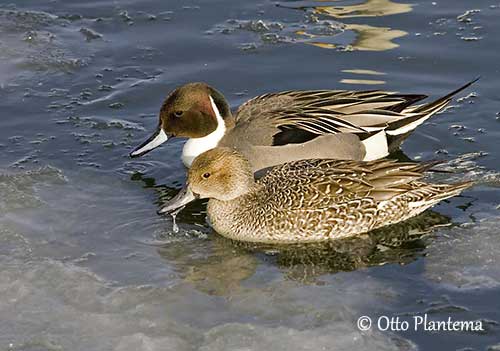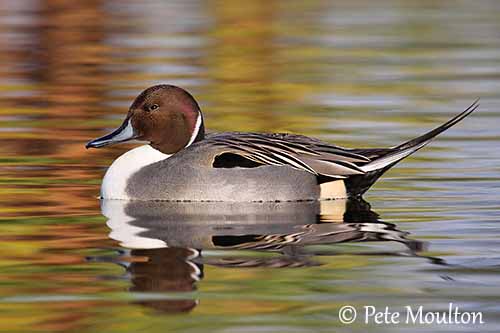
Fr: Canard pilet
Ang: Northern Pintail
All: Spießente
Esp: Ánade rabudo norteño
Ita: Codone comune
Nd: Pijlstaart
Sd: Stjärtand
Photographers:
Steve Garvie
RAINBIRDER Photo galleries & Flickr Rainbirder
Tom Grey
Tom Grey's Bird Pictures
Pete Moulton
Pete Moulton Photography
Otto Plantema
Trips around the world
Ingo Waschkies
Bird Photography
Text by Nicole Bouglouan
Sources:
HANDBOOK OF THE BIRDS OF THE WORLD vol 1 by Josep del Hoyo-Andrew Elliot-Jordi Sargatal - Lynx Edicions - ISBN: 8487334105
GUIDE DES CANARDS, DES OIES ET DES CYGNES – de Steve Madge - Delachaux et Niestlé - ISBN: 2603013769
THE COMPLETE BOOK OF BRITISH BIRDS – Written by “Royal Society for the Protection of Birds” experts - Préface de Magnus Magnusson - Michael Cady- Rob Hume Editors - ISBN: 0749509112
ENCYCLOPEDIE DES OISEAUX DE FRANCE ET D’EUROPE – de Peter Hayman et Rob Hume - Flammarion – ISBN : 2082009920
THE HANDBOOK OF BIRD IDENTIFICATION FOR EUROPE AND THE WESTERN PALEARCTIC by Mark Beaman, Steve Madge - C.Helm - ISBN: 0713639601
BIRDS OF THE GREAT BASIN – by Fred A. Ryser - Univ of Nevada Pr -ISBN: 0874170796
All About Birds (Cornell Lab of Ornithology)
Bird Web (Seattle Audubon Society)
What Bird-The ultimate Bird Guide (Mitchell Waite)
Wikipedia, the free encyclopaedia
WATERFOWL MANAGEMENT HANDBOOK
Life History, Strategies and Habitat Needs of the Northern Pintail
Northern Pintail
Anas acuta
Anseriformes Order – Anatidae Family
INTRODUCTION:
The Northern Pintail has wide geographic range. Its breeding grounds are the northern areas of Europe, Asia and North America. It winters southwards to the equator in N South America, Africa and S and E Asia.
This species is very attractive with nice plumage and elegant form. In flight, it looks long and thin with sharply pointed tail.
The Northern Pintail frequents a variety of wetland habitats all year round. It nests in open areas near water in prairie and tundra habitats. Like most Anatidae, the male does not take part in nesting duties and migrates earlier than female.
This species is one of the commonest ducks throughout most of the range, in spite of habitat loss on both breeding and wintering grounds, pollution and hunting pressure in several parts of the range.

DESCRIPTION OF THE BIRD:
Biometrics:
Length: 51-66 cm (with tail)
Wingspan: 80-95 cm
Weight: M: 850-1030 g – F: 735-870 g
The Northern Pintail adult male in breeding plumage has dark, mostly chocolate-brown head, nape and throat. The white stripe on neck-side, and white lower foreneck, breast and centre of underparts create a strong contrast with the dark head.
Upperparts and flanks are heavily vermiculated grey. The long, pointed scapulars and the tertials are grey with black central stripe. The upperwing is brownish-grey with buff fringes to greater coverts, and bronzy-green speculum, blacker inwards, with narrow, black subterminal band and broad white trailing edge.
The tail is white on the sides with black centre. The two elongated central rectrices of up to 10 centimetres long, show narrow, pale grey fringes.
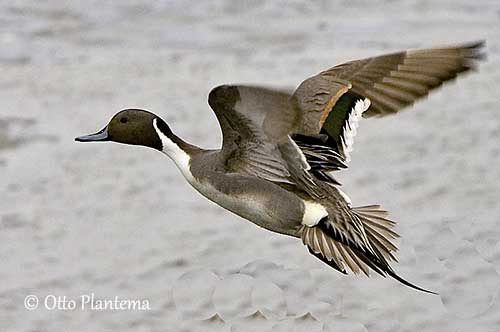
On the underparts, the white foreneck, breast and central underparts become yellowish-buff on belly and vent. The undertail-coverts are black. The underwing is grey with darker coverts.
On the dark head, the bill is blue-grey with black central stripe, nail and cutting edges. The eyes are brown to cinnamon-brown. Legs and webbed feet are grey.
The adult male in eclipse resembles adult female, but it has brighter bill, greyer and longer tertials and green speculum.
The adult female has pale brown head and neck with tiny darker spots and flecks. Throat, foreneck, breast and centre of belly are paler and finely mottled. Flanks are brownish with dark subterminal crescents to feathers.
The upperparts are dark brown with broad subterminal blackish stripe to feathers. The upperwing is grey-brown with pale-tipped greater coverts and dull, brown speculum with white trailing edge.
The bill is duller than in male, with more indistinct dark culmen.
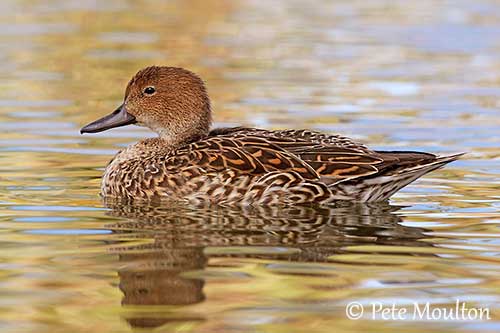
The juvenile resembles female, but it has darker and plainer upperparts and flanks. The underparts are more spotted. The rectrices are brown with buff fringes. The upperwing is duller overall.
The young female resembles young male, but she has unbarred mantle and dark grey-brown speculum.
RANGE:
The Northern Pintail has wide range in most Nearctic and Palearctic regions where it breeds. It winters S to N South America, Africa, S and E Asia.
HABITAT:
The Northern Pintail breeds in open country with dense vegetal cover and shallow, seasonal wetlands including freshwater marshes, small lakes and rivers.
During winter, it can be found on coastal lagoons with brackish or saltwater. It also occurs in farmland and ricefields where it can breed.
This species has been observed up to 4000 metres of elevation in winter in Ethiopia, and 3350 metres at least on passage in SW China.
CALLS AND SONGS: SOUNDS BY XENO-CANTO
The Northern Pintail male gives low, quiet whistle “weeee”, while the female utters a repeated descending series of short quacks, usually weaker than that of Mallard. When disturbed and flushed, she produces a low growling croak.
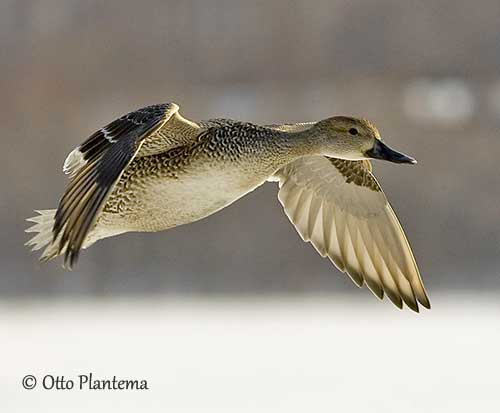
BEHAVIOUR IN THE WILD:
The Northern Pintail feeds primarily on plant matter such as seeds, tubers and parts of aquatic plants and sedges. During the breeding season, in spring and summer, it feeds on aquatic invertebrates including insects, molluscs and crustaceans, but also amphibians and sometimes small fish. Tiny snails called Hydrobia are taken at coastal sites in Britain.
During winter, it feeds mainly on seeds of aquatic plants with only 10% of the diet consisting of animal matter.
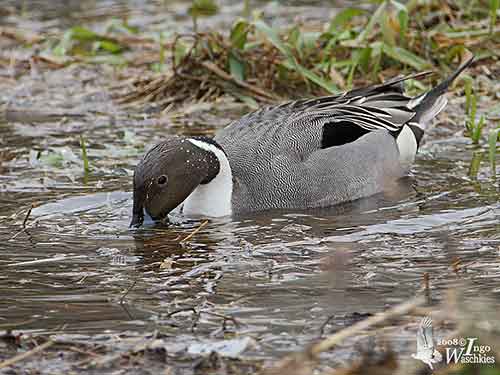
The Northern Pintail, like numerous Anatidae, feeds by upending, dabbling and head-dipping in shallow water. Most food is obtained at 10-30 centimetres depth. On land, it feeds by grazing and picks at grain. It uses the bill for digging out roots and tubers.
When the duck performs upending, the long tail is angled down. However, this feeding behaviour is common in both sexes.
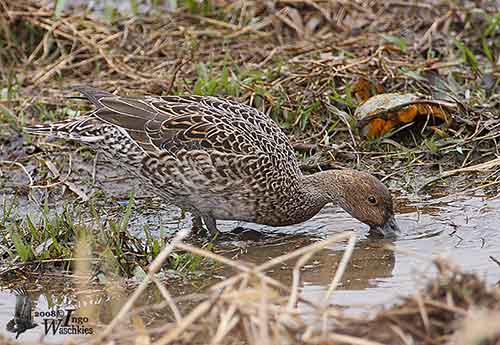
The Northern Pintail forms large flocks at stopovers and on the wintering areas. Males and females gather in flocks for moulting, but separately and at different locations. They are flightless during this period of about three weeks.
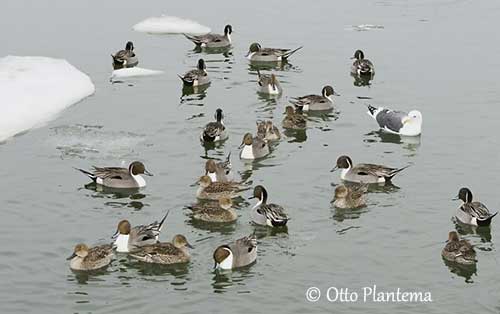
The pairs form in autumn and winter. They arrive together at their breeding grounds. The male defends the female more than the territory.


It performs courtship displays around the female, swimming with the tail raised upright and the bill downwards. It gives a whistling sound while displaying.
However, if several males are courting the same female, they will chase her in flight. At the end, only one male is left and the copulation tales place in the water. The female lays her body, then, the male bobs its head up and down before mounting the female. After mating, it lifts head and back and whistles. They are monogamous for the season.

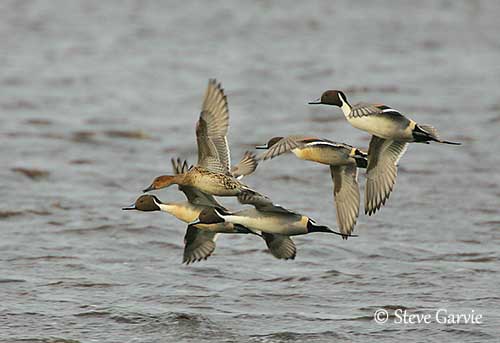
The Northern Pintail is migratory and flies S to winter at lower latitudes. It moves N as soon as wetlands become ice-free. The moult migrations occur mainly from mid-August to early September, at least in N America and Russia.

It may reach speeds of 77 km/h. In flight, it looks long and thin with pointed tail. They often fly in V or linear formation.
REPRODUCTION OF THIS SPECIES:
The breeding season starts in March/May, but the laying may vary depending on the range (mid-May/late April over N and W Europe).
The Northern Pintail nests in single pairs or scattered groups where the nests can be only 2-3 metres apart. The nest is a shallow depression on the ground, hidden among the vegetation and sometimes far from water, usually within 200 metres but sometimes up to 1-2 kilometres from water. This depression is lined with plant matter such as leaves and grass, and some down can be added.
This species produces a single brood per year, but two replacement clutches can be laid is the first brood is lost.
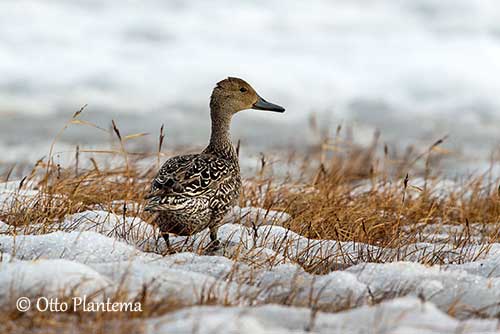
The female lays 7-9 all-white to yellowish-green eggs (6-12 in Europe and 3-14 in N America). The incubation lasts 21-25 days by female alone. At hatching, the chicks have brown or reddish-brown down above and conspicuous eye stripe on the whitish face. The underparts and the dorsal stripes are white. They fledge 40-45 days after hatching. They are tended by the female alone.

PROTECTION / THREATS / STATUS:
The Northern Pintail is common throughout the wide range. However, it is threatened by habitat loss through drainage of wetlands, peat extraction, burning and mowing of reeds, hunting, poisoning from lead shots ingestion and predation by introduced cats and rats on islands.
The population is decreasing, although some populations may appear stable. The global population is estimated to number 5,300,000/5,400,000 individuals, and the Northern Pintail is currently evaluated as Least Concern.
